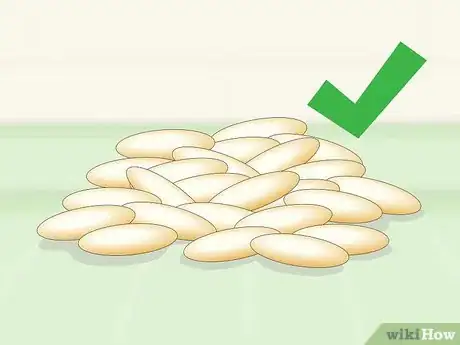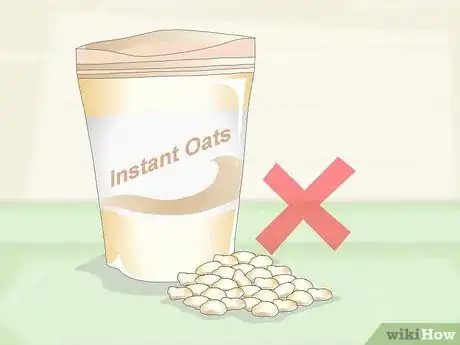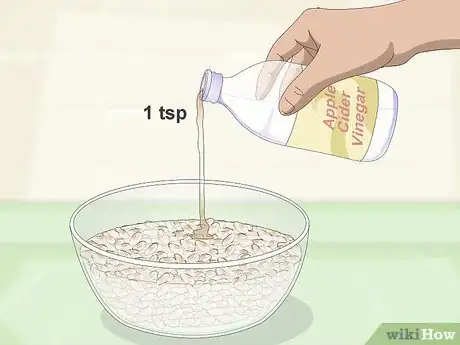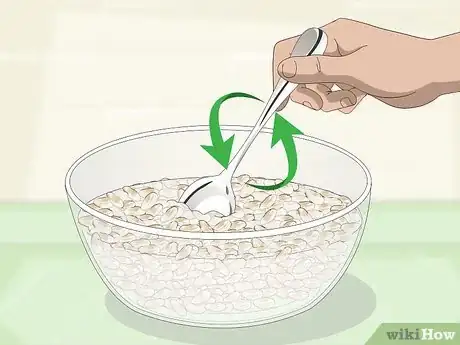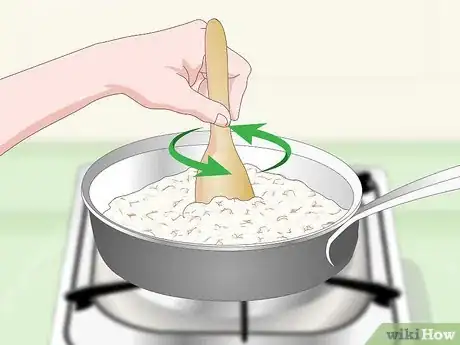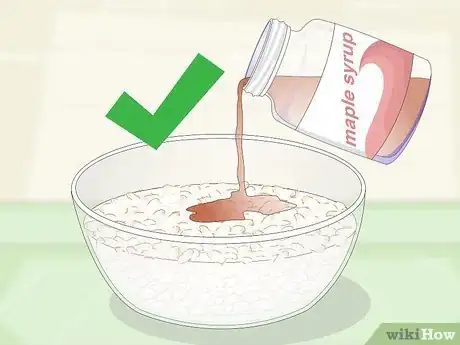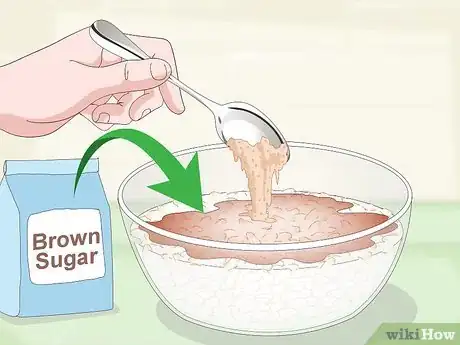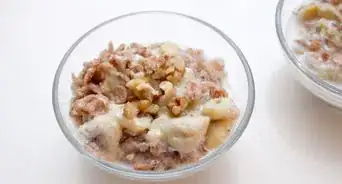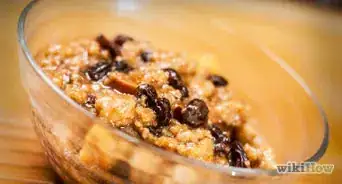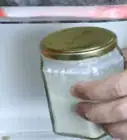This article was co-authored by wikiHow Staff. Our trained team of editors and researchers validate articles for accuracy and comprehensiveness. wikiHow's Content Management Team carefully monitors the work from our editorial staff to ensure that each article is backed by trusted research and meets our high quality standards.
There are 12 references cited in this article, which can be found at the bottom of the page.
This article has been viewed 58,816 times.
Learn more...
Soaked oats can turn boring and bland oatmeal into a delicious breakfast treat. Place your oats in the fridge the night before so they are ready to eat in the morning. Once your oats are soaked, they will require minimal preparation. All you need to add is a little milk and as many toppings as you like for an easy, hearty, and healthy meal.
Steps
Choosing the Ideal Oats for Soaking
-
1Find whole oats for a healthy option. Cut oats often lose fatty acids and other nutrients while being stored. Pick whole oats if you are most interested in your oatmeal's health benefits. The fresh taste of whole oats can complement overnight oatmeal well.[1]
- Whole oats must be rolled at home so don't choose this option unless you own an oat grinder.
-
2Buy rolled oats for preservation. Rolled oats preserve the taste and nutrients in the oats. Before being stored, rolled oats are steamed and flattened into flakes. When soaked overnight, they absorb flavors easily.[2]
- Rolled oats are easily found at most grocery stores, unlike whole oats.
Advertisement -
3Pick steel cut oats for heartier oatmeal. Steel cut oats are chopped up into small pieces before being stored. During the packaging process, they are neither steamed nor rolled. Their flavor is heartier and creamier than rolled or whole oats because they remain firm after absorbing water.[3]
-
4Avoid purchasing quick or instant oats. Although you can make soaked oats from quick or instant brands, they are most likely to taste mushy. Neither has nutritional value thanks to their cheap processing and added preservatives. They are the cheapest but also the least ideal option for overnight oatmeal.
Preparing and Soaking the Oats Mixture
-
1Combine oats, water, and lemon juice in a bowl. The ratio between oats and water should be one to one. If you add one cup (8 oz) of oatmeal to your bowl, for example, you should match it with one cup (8 oz) of water. Add enough lemon juice to taste: in most cases, one tablespoon (0.5 oz) will suffice.[4]
- Although fresh lemon juice tastes best, bottled lemon juice can work as a substitute.
-
2Add apple juice or apple cider vinegar for a sweeter taste (optional). Add in the sweeter liquid one teaspoon at a time until you reach your desired sweetness. Do not add enough liquid to submerge the oats.[5]
- Add a minimal amount of vinegar to your oatmeal, as too much can make it taste tart.
- Because the oats will absorb the liquid, less is more.
-
3Mix in chia seeds for texture. Most toppings will not be added until the oats have soaked overnight. Chia seeds, however, absorb liquid well and stay firm after soaking. For a thicker texture, pour in chia seeds one tablespoon (0.5 oz) at a time.[6]
-
4Stir the mixture until the oats are slightly damp. The oats should not be wet or submerged in water but damp. If you accidentally add too much water, slowly add oats until your mixture reaches a thicker texture. Stir in a little water at a time if your oats appear too dry.[7]
-
5Cover the oats and soak them in the fridge for 12 hours. Place a plastic wrap over your bowl of oats and place it in the fridge. Allow your oats to soak for at least twelve hours before serving. The longer your oats can soak, the more flavor they will absorb.
- Avoid keeping prepared oatmeal in the fridge for any longer than 5-7 days. Freezing is not recommended.[8]
Making Oatmeal from Soaked Oats
-
1Place the soaked oats in a saucepan. Your oats are ready to cook immediately after they are finished soaking. Add 1/3 cup (2.67 oz) of milk to the saucepan to give your oats a creamier taste. Begin at a low stove setting and gradually increase to a medium setting as your oatmeal simmers.[9]
- If your oatmeal begins to boil, your oatmeal is too hot. Turn the stove down to a lower setting.
-
2Stir the oatmeal as it thickens in the pot. Cook your oats in the saucepan for at least four to six minutes. The oatmeal will continue thickening as long as you continue heating it. Taste the oatmeal as you cook so you know when you reach your ideal texture.[10]
-
3Add toppings to your oatmeal. Turn off the heat and place your oatmeal in bowls for serving. Fruit, jam, nut butter, yogurt, cinnamon, maple syrup, and nuts can all make tasty toppings. Lay out a topping bar for you and anyone else eating the oatmeal so they can add whatever toppings they like.[11]
-
4Sweeten your oatmeal with sugar. Soaked oats require more seasoning than other oatmeal to taste sweet. Use brown or raw sugar to sweeten your oatmeal, as it has a richer flavor than granulated sugar.[12]
- Finish seasoning the oatmeal with a pinch of salt.
Things You'll Need
- Oats
- Lemon juice
- Water
- Apple juice or vinegar (optional)
- Chia seeds (optional)
- Milk
- Toppings (like fruit, nut butter, jam, or yogurt)
- Raw or brown sugar
References
- ↑ https://blog.radiantlifecatalog.com/traditional-soaked-oatmeal
- ↑ https://www.keeperofthehome.org/soaking-oatmeal
- ↑ https://www.thekitchn.com/how-to-make-creamy-steelcut-oatmeal-the-make-ahead-method-cooking-lessons-from-the-kitchn-134185
- ↑ https://www.kitchenstewardship.com/monday-mission-soak-your-oatmeal/
- ↑ https://www.tastingtable.com/cook/national/how-to-make-the-best-oatmeal-overnight-oats
- ↑ https://www.katheats.com/favorite-foods/overnightoats
- ↑ http://theelliotthomestead.com/2013/02/how-to-soak-plain-oats/
- ↑ http://www.eatbydate.com/grains/cereal/how-long-does-oatmeal-last-shelf-life-expiration-date-storage/
- ↑ http://www.onegreenplanet.org/vegan-food/reasons-raw-soaked-oats-are-a-must-try/
- ↑ http://nourishedkitchen.com/soaked-oatmeal-recipe/
- ↑ http://phickle.com/soak-those-oats-fermented-oatmeal-is-better-than-your-oatmeal/
- ↑ https://www.bonappetit.com/test-kitchen/common-mistakes/article/how-to-make-overnight-oats
- ↑ http://www.onegreenplanet.org/vegan-food/reasons-raw-soaked-oats-are-a-must-try/
About This Article
Before you soak oats, make sure to purchase steel cut oats, whole oats, or rolled oats from your grocery store. Instant oats are not as healthy and do not need to be soaked. In a large bowl, mix your oats with water using a one to one ratio. For example, for each cup of oats, add one cup of water. Then, add 1 tbsp of lemon juice to your oats and let them soak in the fridge for 12 hours. If you like, you can also add chia seeds for a firmer texture. To learn how to cook oats on the stove and what toppings to add, scroll down!
